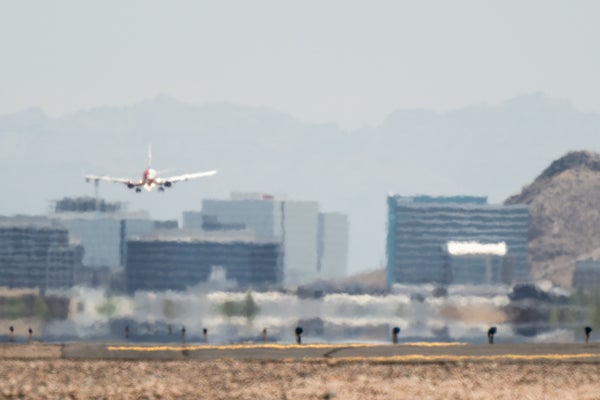CLIMATEWIRE | Last Thursday morning, United Airlines CEO Scott Kirby wanted to talk about the weather. And not in a good way.
He told Wall Street analysts that a wave of thunderstorms had snarled traffic at East Coast airports the weekend before the July 4 holiday and that the ensuing cancellations would affect the company’s finances for the rest of the year.
The same morning, American Airlines CEO Robert Isom was dealing with a similar issue. In his call with analysts, he detailed how the company was addressing the summer’s record-breaking heat — using everything from portable power systems to ice carts to keep its airplanes cool and its ground crews safe.
On supporting science journalism
If you're enjoying this article, consider supporting our award-winning journalism by subscribing. By purchasing a subscription you are helping to ensure the future of impactful stories about the discoveries and ideas shaping our world today.
And by the end of the day Thursday, Delta Air Lines was struggling with weather-related problems, too. Its main issue was blowback from news that one of its flights had sat on the concrete in triple-digit temperatures for about three hours at the airport in Las Vegas.
The delay happened earlier in the week and ultimately resulted in the Delta flight being canceled, according to Reuters. But it caused enough of a scene that Transportation Secretary Pete Buttigieg decided to address the situation — calling it "shocking" and vowing an investigation.
Though the timing is coincidental, industry watchers and academic researchers say the three airlines’ experiences show how the airline industry is being forced to adapt to more extreme weather in a warming world.
"You’d have to have your head in the sand to not think these things are increasing in frequency," said Rob Britton, a former executive at American Airlines who now teaches at Georgetown University.
Scientists have predicted for decades that rising global temperatures would lead to more severe storms, more heat waves and other disruptions. Airlines have historically been good at planning for long-term changes, Britton said, but any adaptation strategy is going to come with a cost.
And not just one, either. Climate change poses a range of threats to aviation, and the effects will be felt across the system, the International Civil Aviation Organization, a U.N. agency, said in a 2020 paper. Rising seas will threaten coastal airports, and more intense storms will disrupt schedules and damage airports and other infrastructure.
“If one airport is directly impacted by climate change, other parts of the network may be affected indirectly, which can cause ripple effects across multiple business and economic sectors,” the paper warned.
Meanwhile, more frequent heat waves could force some airlines to cut their passenger loads, since it’s harder for airplanes to lift off in hotter, thinner air, according to a 2017 paper by researchers at Columbia University and other institutions. In some places, airplanes will have to reduce their weight by 10 to 30 percent during the most extreme heat.
Those effects will be felt most intensely at airports with relatively short runways, such as New York’s LaGuardia and Washington’s Reagan National, the paper said.
The disruptions the airlines are experiencing show the need for the Biden administration’s infrastructure and climate-adaptation spending, which is aimed at making the transportation system more resilient and reducing climate-warming emissions, Transportation Department spokesperson Kerry Arndt told E&E News in a statement.
“We’ve seen once-in-a-generation weather events happening regularly and there is no question that climate change is contributing to that,” she wrote.
The airlines say they’re adapting to the changing conditions. Together, American, Delta and United carry about half the industry’s passengers in the United States, according to the Transportation Department’s most recent data.
United worked closely with the Federal Aviation Administration after the early summer storms, and it was able to handle a second round of storms this month with far fewer cancellations, Kirby said on the conference call.
“We were able to immediately start the recovery as soon as the weather was past,” he said.
American has a lot of experience flying in hot conditions. The company has hubs in Dallas and Miami, and it was forced to cancel dozens of flights out of Phoenix in 2017 when ground temperatures exceeded 120 degrees Fahrenheit.
“We’re really taking this seriously, and we’re going to have to as we go forward,” Isom, the CEO, said.
Delta has said it’s cooperating with the Transportation Department investigation into the Las Vegas delay. The Transportation Department has regulations requiring airlines to maintain comfortable temperatures in airplanes.
“I want to know how it was possible for passengers to be left in triple-digit heat onboard an aircraft for that long," Buttigieg said in a statement. “Even at normal temperatures a tarmac delay is not supposed to go that long and we have rules about that, which we are actively enforcing right now.”
The reaction to the Delta flight delay shows how extreme weather is creating a reputational risk for the airline industry, said Steven Clarke, a senior director at the climate-focused investment group Ceres.
The delays and flight cancellations don’t just come with a financial cost — they threaten the perception that the airlines are fast and reliable, he said.
“If people do start to perceive the airlines as risky or not as reliable, I think you will see a significant mode shift happen where people will get on the train or maybe even drive,” he said.
Reprinted from E&E News with permission from POLITICO, LLC. Copyright 2023. E&E News provides essential news for energy and environment professionals.
